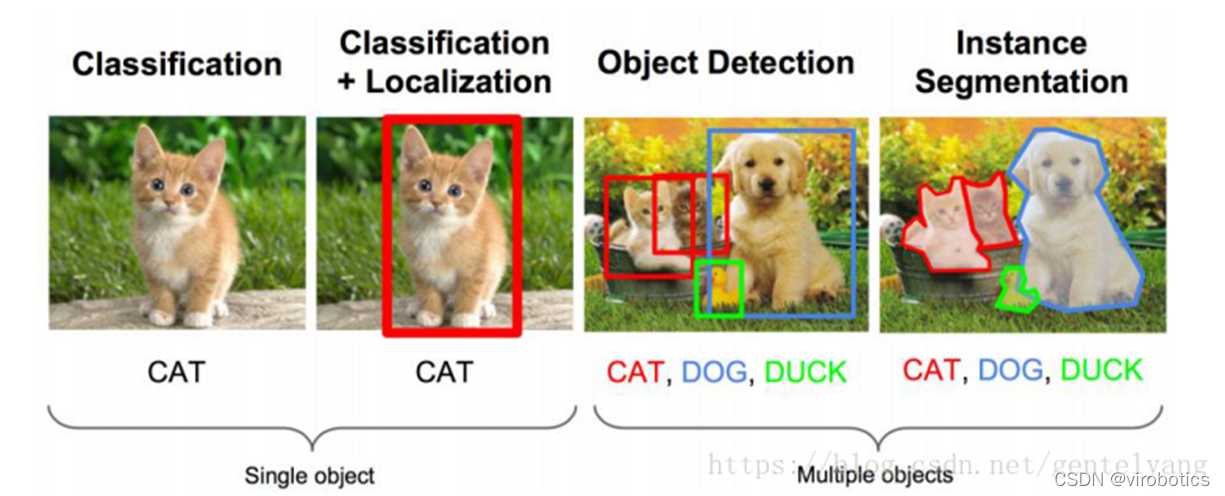手把手教你使用LabVIEW OpenCV dnn实现物体识别(Object Detection)含源码
前言
今天和大家一起分享如何使用LabVIEW调用pb模型实现物体识别,本博客中使用的智能工具包可到主页置顶博客LabVIEW AI视觉工具包(非NI Vision)下载与安装教程中下载
一、物体识别算法原理概述
1、物体识别的概念
物体识别也称目标检测,目标检测所要解决的问题是目标在哪里以及其状态的问题。但是,这个问题并不是很容易解决。形态不合理,对象出现的区域不确定,更不用说对象也可以是多个类别。 
目标检测用的比较多的主要是RCNN,spp- net,fast- rcnn,faster- rcnn;YOLO系列,如YOLOV3和YOLOV4;除此之外还有SSD,ResNet等。
2、Yolo算法原理概述
Yolo的识别原理简单清晰。对于输入的图片,将整张图片分为7×7(7为参数,可调)个方格。当某个物体的中心点落在了某个方格中,该方格则负责预测该物体。每个方格会为被预测物体产生2(参数,可调)个候选框并生成每个框的置信度。最后选取置信度较高的方框作为预测结果。

二、opencv调用darknet物体识别模型(yolov3/yolov4)
相关源码及模型在darknt文件夹下

使用darknet训练yolo的模型,生成weights文件。使用opencv调用生成的模型
1、darknet模型的获取
文件含义:
cfg文件:模型描述文件
weights文件:模型权重文件
Yolov3获取链接:
https://github.com/pjreddie/darknet/blob/master/cfg/yolov3.cfg
https://pjreddie.com/media/files/yolov3.weights
Yolov4获取链接:
https://github.com/AlexeyAB/darknet/releases/download/darknet_yolo_v3_optimal/yolov4.cfg
https://github.com/AlexeyAB/darknet/releases/download/darknet_yolo_v3_optimal/yolov4.weights
2、python调用darknet模型实现物体识别
(1)dnn模块调用darknet模型
net = cv2.dnn.readNetFromDarknet("yolov3/yolov3.cfg", "yolov3/yolov3.weights")(2)获取三个输出端的LayerName
使用getUnconnectedOutLayer获取三个只有输入,没有输出的层的名字,Yolov3的三个输出端层名为:['yolo_82', 'yolo_94', 'yolo_106']
def getOutputsNames(net):
# Get the names of all the layers in the network
layersNames = net.getLayerNames()
# Get the names of the output layers, i.e. the layers with unconnected outputs
return [layersNames[i - 1] for i in net.getUnconnectedOutLayers()](3)图像预处理
使用blobFromImage将图像转为image Size=(416,416)或(608,608) Scale=1/255 Means=[0,0,0]
blob = cv2.dnn.blobFromImage(frame, 1/255, (416, 416), [0,0,0], 1, crop=False)(4)推理
使用net.forward(multiNames)获取多个层的结果,其中getOutputsNames(net)=['yolo_82', 'yolo_94', 'yolo_106']
net.setInput(blob)
outs = net.forward(getOutputsNames(net))(5)后处理(postrocess)
获取的结果(outs)里面有三个矩阵(out),每个矩阵的大小为85*n,n表示检测到了n个物体,85的排列顺序是这样的:
第0列代表物体中心x在图中的位置(0~1)
第1列表示物体中心y在图中的位置(0~1)
第2列表示物体的宽度
第3列表示物体的高度
第4列是置信概率,值域为[0-1],用来与阈值作比较决定是否标记目标
第5~84列为基于COCO数据集的80分类的标记权重,最大的为输出分类。使用这些参数保留置信度高的识别结果(confidence>confThreshold)
def postprocess(frame, outs):
frameHeight = frame.shape[0]
frameWidth = frame.shape[1]
classIds = []
confidences = []
boxes = []
classIds = []
confidences = []
boxes = []
for out in outs:
for detection in out:
scores = detection[5:]
classId = np.argmax(scores)
confidence = scores[classId]
if confidence > confThreshold:
center_x = int(detection[0] * frameWidth)
center_y = int(detection[1] * frameHeight)
width = int(detection[2] * frameWidth)
height = int(detection[3] * frameHeight)
left = int(center_x - width / 2)
top = int(center_y - height / 2)
classIds.append(classId)
confidences.append(float(confidence))
boxes.append([left, top, width, height])
print(boxes)
print(confidences)(6)后处理(postrocess)
使用NMSBoxes函数过滤掉重复识别的区域。
indices = cv.dnn.NMSBoxes(boxes, confidences, confThreshold, nmsThreshold)
for i in indices:
box = boxes[i]
left = box[0]
top = box[1]
width = box[2]
height = box[3]
drawPred(classIds[i], confidences[i], left, top, left + width, top + height)(7)画出检测到的对象
def drawPred(classId, conf, left, top, right, bottom):
# Draw a bounding box.
cv.rectangle(frame, (left, top), (right, bottom), (0, 0, 255))
label = '%.2f' % conf
# Get the label for the class name and its confidence
if classes:
assert(classId < len(classes))
label = '%s:%s' % (classes[classId], label)
#Display the label at the top of the bounding box
labelSize, baseLine = cv.getTextSize(label, cv.FONT_HERSHEY_SIMPLEX, 0.5, 1)
top = max(top, labelSize[1])
cv.putText(frame, label, (left, top), cv.FONT_HERSHEY_SIMPLEX, 0.5, (255,255,255))(8)完整源码及检测结果(cv_call_yolo.py)
import cv2
cv=cv2
import numpy as np
import time
net = cv2.dnn.readNetFromDarknet("yolov3/yolov3.cfg", "yolov3/yolov3.weights")
net.setPreferableBackend(cv2.dnn.DNN_BACKEND_CUDA)
net.setPreferableTarget(cv2.dnn.DNN_TARGET_CUDA)
confThreshold = 0.5 #Confidence threshold
nmsThreshold = 0.4 #Non-maximum suppression threshold
frame=cv2.imread("dog.jpg")
classesFile = "coco.names";
classes = None
with open(classesFile, 'rt') as f:
classes = f.read().rstrip('\n').split('\n')
def getOutputsNames(net):
# Get the names of all the layers in the network
layersNames = net.getLayerNames()
# Get the names of the output layers, i.e. the layers with unconnected outputs
return [layersNames[i - 1] for i in net.getUnconnectedOutLayers()]
print(getOutputsNames(net))
# Remove the bounding boxes with low confidence using non-maxima suppression
def postprocess(frame, outs):
frameHeight = frame.shape[0]
frameWidth = frame.shape[1]
classIds = []
confidences = []
boxes = []
# Scan through all the bounding boxes output from the network and keep only the
# ones with high confidence scores. Assign the box's class label as the class with the highest score.
classIds = []
confidences = []
boxes = []
for out in outs:
for detection in out:
scores = detection[5:]
classId = np.argmax(scores)
confidence = scores[classId]
if confidence > confThreshold:
center_x = int(detection[0] * frameWidth)
center_y = int(detection[1] * frameHeight)
width = int(detection[2] * frameWidth)
height = int(detection[3] * frameHeight)
left = int(center_x - width / 2)
top = int(center_y - height / 2)
classIds.append(classId)
confidences.append(float(confidence))
boxes.append([left, top, width, height])
# Perform non maximum suppression to eliminate redundant overlapping boxes with
# lower confidences.
print(boxes)
print(confidences)
indices = cv.dnn.NMSBoxes(boxes, confidences, confThreshold, nmsThreshold)
for i in indices:
#print(i)
#i = i[0]
box = boxes[i]
left = box[0]
top = box[1]
width = box[2]
height = box[3]
drawPred(classIds[i], confidences[i], left, top, left + width, top + height)
# Draw the predicted bounding box
def drawPred(classId, conf, left, top, right, bottom):
# Draw a bounding box.
cv.rectangle(frame, (left, top), (right, bottom), (0, 0, 255))
label = '%.2f' % conf
# Get the label for the class name and its confidence
if classes:
assert(classId < len(classes))
label = '%s:%s' % (classes[classId], label)
#Display the label at the top of the bounding box
labelSize, baseLine = cv.getTextSize(label, cv.FONT_HERSHEY_SIMPLEX, 0.5, 1)
top = max(top, labelSize[1])
cv.putText(frame, label, (left, top), cv.FONT_HERSHEY_SIMPLEX, 0.5, (255,255,255))
blob = cv2.dnn.blobFromImage(frame, 1/255, (416, 416), [0,0,0], 1, crop=False)
t1=time.time()
net.setInput(blob)
outs = net.forward(getOutputsNames(net))
print(time.time()-t1)
postprocess(frame, outs)
t, _ = net.getPerfProfile()
label = 'Inference time: %.2f ms' % (t * 1000.0 / cv.getTickFrequency())
cv.putText(frame, label, (0, 15), cv.FONT_HERSHEY_SIMPLEX, 0.5, (0, 0, 255))
cv2.imshow("result",frame)

3、LabVIEW调用darknet模型实现物体识别yolo_example.vi
(1)LabVIEW调用yolov3的方式及步骤和python类似,源码如下所示:  将带识别图片与yolo_example.vi置于同一路径下,即可进行物体识别
将带识别图片与yolo_example.vi置于同一路径下,即可进行物体识别
(2)识别结果如下:

4、LabVIEW实现实时摄像头物体识别(yolo_example_camera.vi)
(1)使用GPU加速
使用顺序结构检测神经网络推理的时间

比较使用GPU和不使用GPU两种情况下的推理速度
普通模式:net.serPerferenceBackend(0),net.serPerferenceTarget(0)
Nvidia GPU模式:net.serPreferenceBackend(5), net.serPerferenceTarget(6)

注:普通的c++、python、LabVIEW版本的opencv,即便选了GPU模式也没用,程序仍然运行在CPU上,需要安装CUDA和CUDNN后重新从源码编译opencv
(2)程序源码如下:
 (3)物体识别结果如下:
(3)物体识别结果如下:

注意,使用如上程序,可以点击STOP按钮,停止本次物体识别,也可勾选使用GPU进行加速
(4)使用GPU加速结果:

三、tensorflow的物体识别模型调用
相关源码及模型在tf1文件夹下

1、下载预训练模型并生成pbtxt文件
(1)下载ssd_mobilenet_v2_coco,下载地址如下: http://download.tensorflow.org/models/object_detection/ssd_mobilenet_v2_coco_2018_03_29.tar.gz
(2)解压后的文件内容

(3)根据pb模型生成pbtxt文件 运行 tf_text_graph_ssd.py以生成pptxt文件 在cmd中运行: python tf_text_graph_ssd.py --input ssd_mobilenet_v1_coco_2017_11_17/frozen_inference_graph.pb --config ssd_mobilenet_v1_coco_2017_11_17/ssd_mobilenet_v1_coco.config --output ssd_mobilenet_v1_coco_2017_11_17.pbtxt
2、LabVIEW调用tensorflow模型推理并实现物体识别(callpb.vi)
(1)程序源码如下:

(2)运行结果如下:

四、项目源码及模型下载
链接:https://pan.baidu.com/s/1zwbLQe0VehGhsqNIHyaFRw?pwd=8888 提取码:8888
总结拓展
可以使用Yolov3训练自己的数据集,具体训练方法可参考博客:https://blog.csdn.net/qq_38915710/article/details/97112788 可实现案例:口罩佩戴识别、肺炎分类、CT等,如口罩佩戴检测

更多关于LabVIEW与人工智能技术,可添加技术交流群进一步探讨。qq群号:705637299,请备注暗号:LabVIEW 机器学习
手把手教你使用LabVIEW OpenCV dnn实现物体识别(Object Detection)含源码的更多相关文章
- 手把手教你使用LabVIEW OpenCV DNN实现手写数字识别(含源码)
@ 目录 前言 一.OpenCV DNN模块 1.OpenCV DNN简介 2.LabVIEW中DNN模块函数 二.TensorFlow pb文件的生成和调用 1.TensorFlow2 Keras模 ...
- 手把手教你使用LabVIEW OpenCV dnn实现图像分类(含源码)
@ 目录 前言 一.什么是图像分类? 1.图像分类的概念 2.MobileNet简介 二.使用python实现图像分类(py_to_py_ssd_mobilenet.py) 1.获取预训练模型 2.使 ...
- 手把手教你如何用 OpenCV + Python 实现人脸识别
下午的时候,配好了OpenCV的Python环境,OpenCV的Python环境搭建.于是迫不及待的想体验一下opencv的人脸识别,如下文. 必备知识 Haar-like 通俗的来讲,就是作为人脸特 ...
- 【YOLOv5】手把手教你使用LabVIEW ONNX Runtime部署 TensorRT加速,实现YOLOv5实时物体识别(含源码)
前言 上一篇博客给大家介绍了LabVIEW开放神经网络交互工具包[ONNX],今天我们就一起来看一下如何使用LabVIEW开放神经网络交互工具包实现TensorRT加速YOLOv5. 以下是YOLOv ...
- 【YOLOv5】LabVIEW+YOLOv5快速实现实时物体识别(Object Detection)含源码
前言 前面我们给大家介绍了基于LabVIEW+YOLOv3/YOLOv4的物体识别(对象检测),今天接着上次的内容再来看看YOLOv5.本次主要是和大家分享使用LabVIEW快速实现yolov5的物体 ...
- 手把手教你使用LabVIEW人工智能视觉工具包快速实现传统Opencv算子的调用(含源码)
前言 今天我们一起来使用LabVIEW AI视觉工具包快速实现图像的滤波与增强:图像灰度处理:阈值处理与设定:二值化处理:边缘提取与特征提取等基本操作.工具包的安装与下载方法可见之前的博客. 一.图像 ...
- 手把手教你使用LabVIEW实现Mask R-CNN图像实例分割
前言 前面给大家介绍了使用LabVIEW工具包实现图像分类,目标检测,今天我们来看一下如何使用LabVIEW实现Mask R-CNN图像实例分割. 一.什么是图像实例分割? 图像实例分割(Instan ...
- 手把手教你使用LabVIEW人工智能视觉工具包快速实现图像读取与采集(含源码)
目录 前言 一.工具包位置 二.图像采集与色彩空间转换 1.文件读写 2.实现图片读取 3.使用算子cvtColor实现颜色空间转换 三.从摄像头采集图像 1.Camera类 2.属性节点 3.实现摄 ...
- 10分钟学会使用YOLO及Opencv实现目标检测(下)|附源码
将YOLO应用于视频流对象检测 首先打开 yolo_video.py文件并插入以下代码: # import the necessary packages import numpy as np impo ...
随机推荐
- maven项目(引入依赖失败, pom.xml 报错\爆红)
引入项目过程中,idea引入磁盘的某个的maven项目 这里以springboot项目以例子,发现pom.xml 的依赖大面积爆红,springboot的版本依赖也报错了,然后发现下面有进度条在下载, ...
- PLC中增益和偏移
y=kx+b这个直线方程,那么增益就是指k这个斜率,而偏移就是指b. 模拟量转换时一般是不需要设置这两个参数的,只有当外部信号与模块接收的信号在值上有偏差的情况下才会去调整这个参数. 如果的模块信号是 ...
- MySQL 数据操纵语句
插入 插入多个字段 insert into grade (`name`) values ('大一'),('大二'),('大三'),('大四'); 修改 设置时间为当前时间 update `studen ...
- 大家都能看得懂的源码(一)ahooks 整体架构篇
本文是深入浅出 ahooks 源码系列文章的第一篇,该系列已整理成文档-地址.觉得还不错,给个 star 支持一下哈,Thanks. 第一篇主要介绍 ahooks 的背景以及整体架构. React h ...
- java单线程100%利用率
容器内就获取个cpu利用率,怎么就占用单核100%了呢 背景:这个是在centos7 + lxcfs 和jdk11 的环境上复现的 目前这个bug已经合入到了开源社区, 链接为 https://git ...
- 十周周末总结 MySQL的介绍与使用
python 十周周末总结 MySQL的介绍与使用 MySQL字符编码与配置文件 查看数据库的基本信息(用户,字符编码) /s windos下MySQL默认的配置文件 my_default.ini 修 ...
- 技术管理进阶——技术Leader需要数据思维
原创不易,求分享.求一键三连 假设我长得很漂亮,拥有众多追求者,但是初出闺房的我对这世界上的男人毫无认知,那么该如何选择呢?这真是一个问题! 妈妈说,愿意为我花钱的男人未必爱我,但不愿意为我花钱的男人 ...
- 【Homebrew】安装
/bin/zsh -c "$(curl -fsSL https://gitee.com/cunkai/HomebrewCN/raw/master/Homebrew.sh)" 官网安 ...
- idea中设置注释颜色
1. 打开idea,右上角File-->Settings 2.找到Language Defaults-->Comments里面Block comment和Line comment 3.Bl ...
- 抛砖系列之git仓库拆分工具git-filter-repo
最近负责把团队内的git仓库做了一次分拆,解锁一个好用的工具git-filter-repo,给大伙抛砖一波,希望以后遇到类似场景时可以信手拈来. 背景 笔者团队目前是把业务相关的java项目都放到了一 ...
